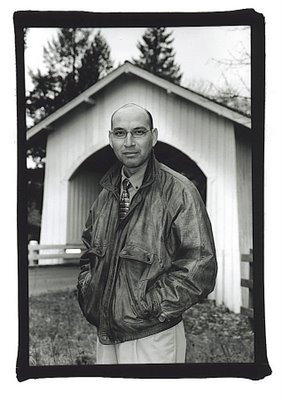A Sense of Place
People and places. If you break it all down, that's really what our lives are all about. And by visually blending the two elements together, the art that results is a photojournalistic original: the Environmental Portrait. The National Press Photographers Association (NPPA) defines a portrait as a picture that captures a unique aspect of the subject's character and personality and/or environment. I believe the environmental portrait embodies all of these qualities.

Whether it's by accident, choice, or default, the selection and use of an environment distinguishes this type of portraiture. But effectively conveying this sense of place is determined by a host of situational factors. For example: how large is the environment, how much of it does the viewer need to see, and should it accentuate or dominate the image? Two key ingredients to think about include: the message--should it be direct or indirect, ambiguous or concrete; and the mood--should it be active or passive and concealing or revealing?
When I was assigned to create environmental portraits of several Hispanic residents for a series highlighting ethnic differences and similarities, I became convinced that a (very--20mm) wide angle lens can make any environment work.
 Sometimes environmental portraits simply fall into place, like the canine corps officer and his trusty companion. I only needed to follow them for a short distance through the caverns of their training facility when the subjects stepped right into the perfect spot.
Sometimes environmental portraits simply fall into place, like the canine corps officer and his trusty companion. I only needed to follow them for a short distance through the caverns of their training facility when the subjects stepped right into the perfect spot.

Whether it's by accident, choice, or default, the selection and use of an environment distinguishes this type of portraiture. But effectively conveying this sense of place is determined by a host of situational factors. For example: how large is the environment, how much of it does the viewer need to see, and should it accentuate or dominate the image? Two key ingredients to think about include: the message--should it be direct or indirect, ambiguous or concrete; and the mood--should it be active or passive and concealing or revealing?
When I was assigned to create environmental portraits of several Hispanic residents for a series highlighting ethnic differences and similarities, I became convinced that a (very--20mm) wide angle lens can make any environment work.
 Sometimes environmental portraits simply fall into place, like the canine corps officer and his trusty companion. I only needed to follow them for a short distance through the caverns of their training facility when the subjects stepped right into the perfect spot.
Sometimes environmental portraits simply fall into place, like the canine corps officer and his trusty companion. I only needed to follow them for a short distance through the caverns of their training facility when the subjects stepped right into the perfect spot.Other times, these images require a lot more effort. Photographing a career holding college student single mother with her family of four in their modest but immaculate apartment demanded a thorough search of the location and then careful placement of the subjects.
The most difficult thing for me is a portrait. You have to try and put your camera between the skin of a person and his shirt. - Henri Cartier-Bresson


0 Comments:
Post a Comment
<< Home